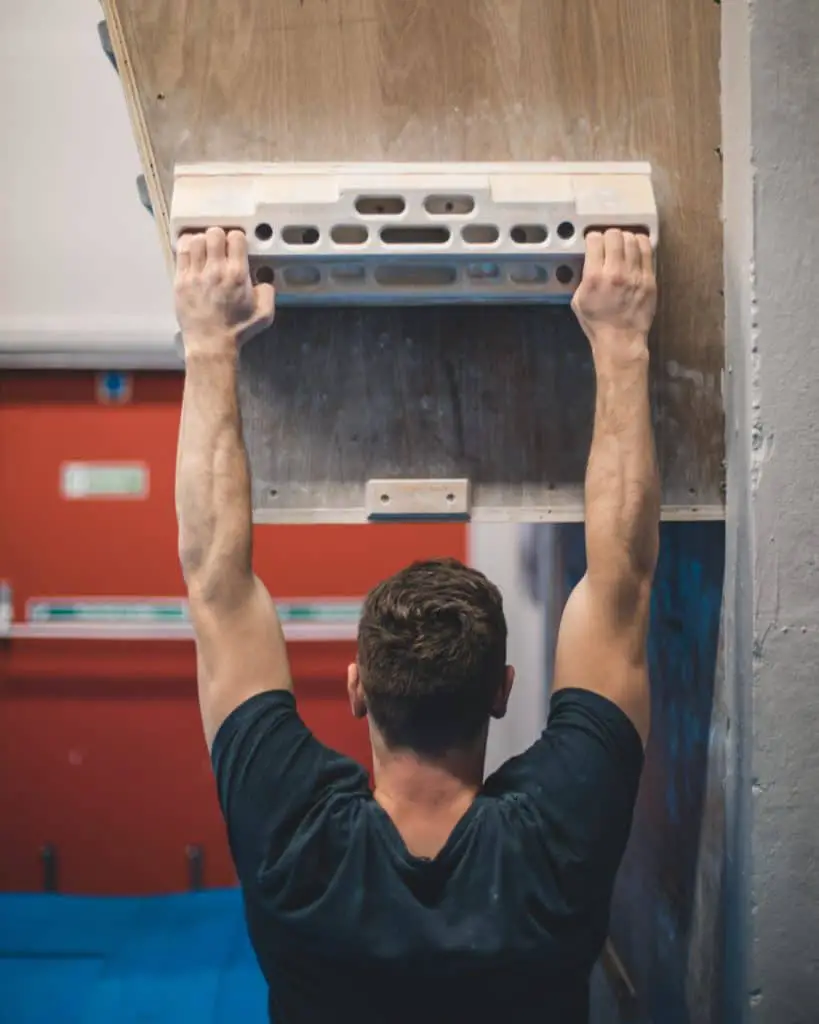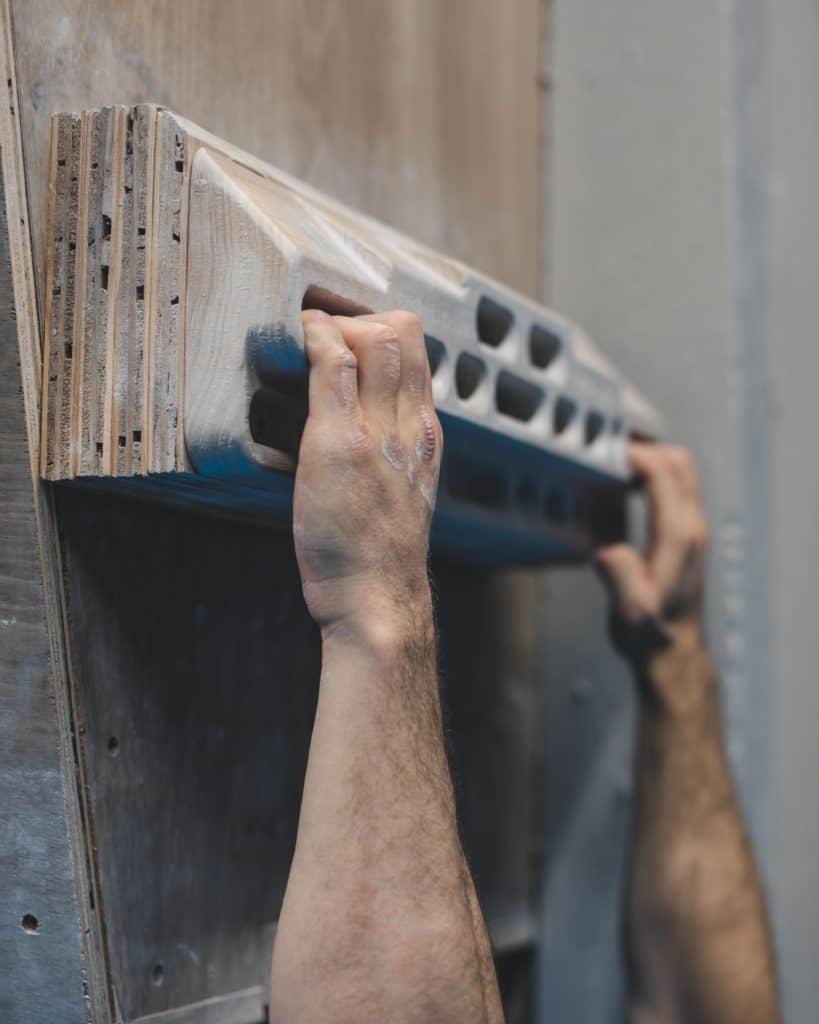
You may be worried about overworking your fingers on a hangboard or not using it enough to strengthen them properly. It is a balancing act to make sure you are getting enough out of the tool without stressing the joints and tendons in your fingers. In this article, we provide information on what hangboards are and how to use them safely.
So, how often should you hangboard? Hangboards are not for beginners, but they are an excellent tool for intermediate and advanced climbers. Unless you are training for sports competitions, you should use a hangboard 2 or 3 times a week. Scientific research has found that it is a great way to increase finger and hand strength even with minimal training sessions per week.
Page Jumps
- Should You Hangboard Every Day?
- How Often Should You Hangboard Per Week?
- What is Hangboarding?
- Modern Hangboard Materials
- Are Hangboards Worth It?
- How Do You Hangboard Safely?
- Should You Hangboard as a Beginner
Should You Hangboard Every Day?
Hangboarding every day would result in injuries to your fingers and hands due to overstressing the tendons, pulleys, and bones. The maximum number of hangboard sessions per week for an advanced sports trained climber should be five.
For intermediate and beginner hangboard users, two times a week is plenty, but you can do up to three as long as you stop at the first sign of finger pain. Pain is an indicator that you are overworking your fingers and hands. Exercising through the pain could lead to a pulley tear, microfracture, or tendinitis. Be conscious of what your body is telling you, and do not go past your threshold.
How Often Should You Hangboard Per Week?
So, can you hangboard every day or most days of the week? The short answer is no. You can develop osteoarthritis from overworking your hands and fingers. A study by the Department of Anthropology at the University of Tennessee looked at how experienced climbers were affected by doing an exorbitant amount of training sessions. You can read the research here. In this study they “conclude that intensive finger training (e.g., campus board training) can lead to early-onset osteoarthritis of the hand.”
Research conducted by the Faculty of Sport Sciences at Castilla La-Mancha University in Spain has shown quite clearly that even a few weeks of hangboarding can substantially increase finger strength. They compared maximum dead-hangs, which involved added weight, intermediate dead-hangs, where they used a minimal edge depth and combination of the two. What their results showed was that “the intermittent dead-hangs training method seems to be more effective for grip endurance development after eight-week application in advanced sport-climbers.” You can read more about that study here.
In the study listed above, the results were obtained with only three hangboarding sessions a week for eight weeks. The “grip endurance gains and effect size were 34%” for the advanced sports climbers who took part in the study. In the end, hangboarding is a fantastic way to gain strength, but it needs to be done in moderation. Two sessions a week for four weeks is enough to see significant improvements.

What is Hangboarding?
Below we go over what hangboards are used for and the different types that are currently used by sports and hobbyist rock climbers.
Hangboarding History and Design
Experienced sports and hobbyist climbers were finding new ways to train their upper forearms, fingers, and hands in the late 1900s when the first modern-looking hangboards were created. They were made of boards with drilled out finger holes and ledges. By the early 2000s, plastic and wooden hangboards were available for purchase and sold by workout gurus.
These boards are made with ledged areas where you can hold yourself at a dead-lift by your fingertips. They are meant to build up the tendon and muscles. Research has also shown that routine use can thicken the bone as well.
The boards are highly flexible in terms of design with many different types and sizes of ledges and handholds to help train specific climbing position strength. Any hangboard you purchase should have open and closed handed holds in a variety of sizes.
Modern Hangboard Materials
There are many different designs for hangboards and materials that they can be made out of though the two most popular materials are wood or plastic.
Many climbers also create their hangboards using wood and hand tools, or they buy kits. This is useful in that it allows for climbers to design boards and grips that will train the part of their hands or fingers that are weakest. However, any possible finger training you might need will have a hangboard available on the market to buy.
Is Plastic or Wood Better?
The two primary materials for hangboards are wood and plastic. The plastic versions with texture are more comfortable to use for people who tend to have sweaty fingers when they work out. Wood is usually better if you are a climber who wants to use added weight during training as there is a little give to the material, so it does not bite into your fingers as plastic would. Both elements work perfectly fine, but they have their pros and cons.
Plastic
There are now patterns for 3D printers that you can augment to your desired size to make sure it has everything you want and will fit your hands exactly. If you do not want to spend the money on custom made boards then there are plenty of ones available online and in stores that sell workout gear. They are usually made of polyester resin or polyurethane. There is no actual difference between the materials though some trainers have claimed that polyurethane is lighter. Plastic is cheaper and easier to find.
Wood
Unless you make your wooden hangboard at home, they are the more expensive option. Usually, they are made of high-quality wood, and they are a lot easier on your skin than the harder plastics. There are plenty of patterns for making your wooden hangboard at home, so if you feel confident in your carpentry skills, you can save some money and build a board to your exact size and needs with a board and some power tools. Wood boards are expensive but more comfortable.
I’ve tried many different hangboards over the years, and I’ve definitely found my favorites. Because of this I’ve got an article on my best hangboards that can save you time and money.
Are Hangboards Worth It?
You will see an improvement in your grip strength within a short time if you follow proper hangboard guidelines. You should always speak with your doctor before starting any new workout routine, but hangboarding is a relatively low-stress exercise that yields significant results.
What Science Says about Hangboards
A controlled scientific trial by Jerry Medernach, Heinz Kleinöder and Helmut H H Lötzerich found that when they had 23 advanced bouldering men try four weeks on a hangboard, the results were positive. “[Fingerboarding] is highly effective in increasing grip strength and endurance in competitive [Bouldering].” You can see all the study findings here.
Why Hangboards are Useful
Here are just a few ways that hangboarding can help you with your climbing.
- It is highly controlled so you can strengthen the grip positions where you are weakest.
- You can add or subtract weights so there can be precise resistance training.
- This form of exercise makes it easier to work-out without having to worry about accidents or injuries.
- The boards are easy to access and very portable, so they are incredibly accessible to almost anyone who might need one.
How Do You Hangboard Safely?
If you ever experience finger or hand pain when doing hangboarding, stop immediately. You should also not use the board when you are injured and the advice of medical professionals. Rest after training to allow your body to use the exercise you just completed to grow stronger.
Warm-Ups
You want to do about thirty minutes of warm-ups before you start to avoid any possible injury. You can start with a full-body workout such as jogging or jumping jacks. Then get your upper body ready for the dead-lifts with some pull-ups or rotator cuff warm-ups. Stretch all of your fingers and your forearms before you begin. Then, once you get started, do a few quick rounds on the holds you intend to practice. Doing all of this will keep your body from cramping and will help you be able to hold your positions better. Do a few light stretches when you are done as well to keep the muscles from cramping.
Hand Position
There are multiple hand positions depending on what part of your hand you are trying to strengthen. A basic boarding exercise involves using four fingers to create an open and grip on matching holds on either side of the board. Forms for building strength in specific areas of the hand can be found in online video tutorials, where professional climbers can give examples of each. Never use a full-hand crimp when using the board.
Shoulder and Body Position
Your shoulders should always be down and relaxed rather than high and bunched together. Your chest should be out and your knees only slightly bent so that you can engage your core.
Dismounting Safely
Always slowly lower yourself to the floor. If you drop suddenly, it can damage your tendons.
Should You Hangboard as a Beginner
If you are new to the sport, then you may be wondering when you should start hangboarding. It is important not to start immediately. You should wait at least 6 months of rock climbing training as a beginner before you attempt to use a hangboard. This will get your forearms used to building up some initial grip strength and proper form so that you do not injure yourself when you start hangboarding.

